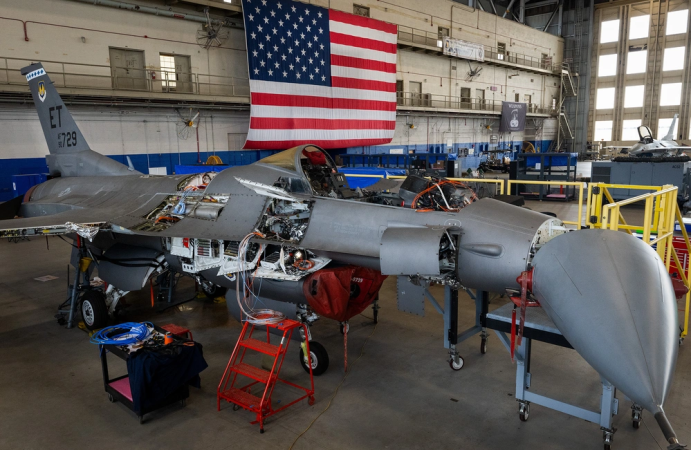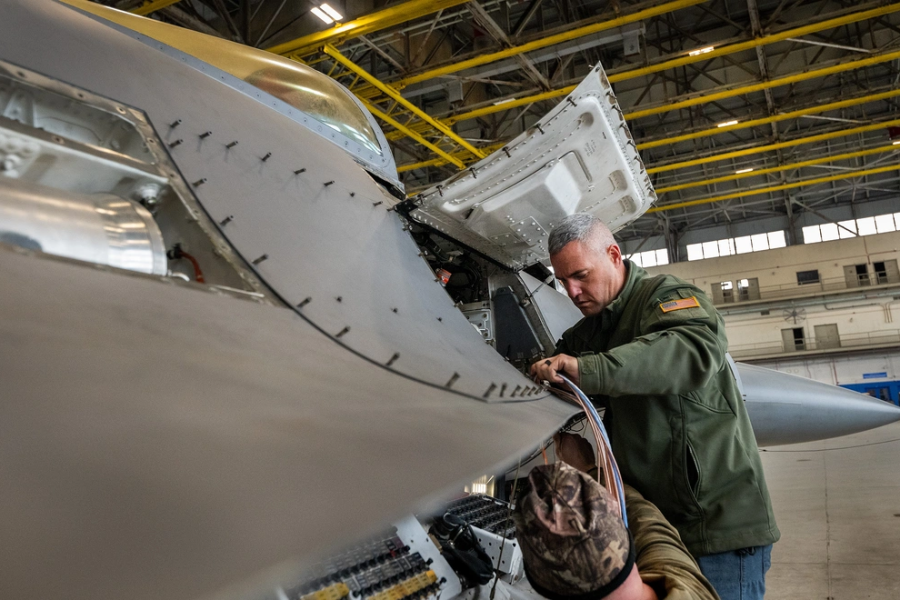A test program meant to pave the way for Collaborative Combat Aircraft drones took another step toward flight April 1 with the arrival of the last fighter jet to complete its fleet.
An F-16 landed at Eglin Air Force Base Fla., to join the Viper Experimentation and Next-gen Operations Model-Autonomy Flying Testbed program, or VENOM for short, according to a recent press release. That brings the total to number of F-16s for VENOM to six, a base spokesperson told Air & Space Forces Magazine.
VENOM is part of the Air Force’s effort to develop Collaborative Combat Aircraft (CCA), which will integrate unmanned, semi-autonomous drones with manned platforms. Because CCAs are less costly than manned aircraft, they offer a way to beef up the Air Force’s shrinking number of combat aircraft.
The VENOM effort is similar to, but separate from, the X-62 Vista, another program where the Air Force is modifying an F-16 to explore the maneuvering and tactics of autonomous aircraft. VENOM focuses specifically on manned/unmanned teaming development.
“With regards to VENOM-AFT, rapid tactical autonomy development focuses on ‘speed-to-ramp,’ meaning, go as fast as you can, safely, to ensure we get CCA flying as quickly as possible,” Lt. Col. Joe Gagnon, commander of the 85th Test and Evaluation Squadron at Eglin, said in a press release last April when the first three F-16s arrived to be modified for VENOM.
In April 2024, the first three aircraft for VENOM arrived at Eglin to be modified. In its latest release, the base said those aircraft are still being worked on. Modifications include software, hardware, and instrumentation adjustments that let the aircraft fly autonomously. But pilots will still sit in the cockpit to monitor the systems and provide feedback.
The latest jet joins that modification process.

Even while the jets are still being physically modified, the VENOM program has modeled and simulated “countless aircraft combat scenarios” since 2024, including one-on-one and two-on-one combat and within-visual-range and beyond-visual-range, according to the release.
“These simulations provide an efficient way to train the autonomy to learn complex air combat tactics.” Maj. Trent McMullen, the 40th Flight Test Squadron’s advanced capabilities division chief, said in the release.
“A specific scenario can be run 1,000 times and the variations and decisions made throughout that mission can be studied,” he added. “We can then make recommendations to the developers on how to improve the autonomy’s behaviors and overall performance.”
On the hardware side, the goal is to ensure autonomous commands cannot break the aircraft by exceeding its flight envelope, or the pilot by exceeding human tolerance for aggressive maneuvers, McMullen explained.
When software and hardware tests are done, a fully-modified VENOM F-16 will enter ground testing, which will likely move fast because operational and developmental test are both at Eglin.
The release said a fully-modified F-16 may be ready to start testing within first 18 months of the first jet arriving. That means tests should start in October.
“As the VENOM program’s first flight approaches, we are excited to test novel autonomous solutions,” McMullen said. “The strides we’ve witnessed in the simulation environment suggest VENOM will help advance aerial combat capabilities for future crewed and uncrewed platforms.”
In March, Air Force Chief of Staff Gen. David W. Allvin unveiled the service’s first two CCAs, one produced by General Atomic called the YFQ–42A, and another produced by Anduril Industries dubbed the YFQ–44A.
